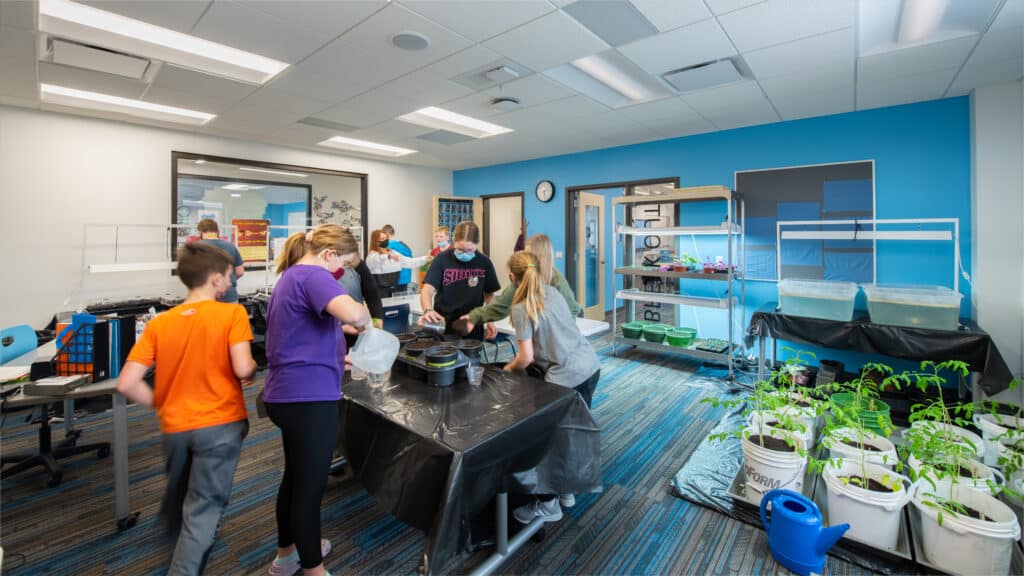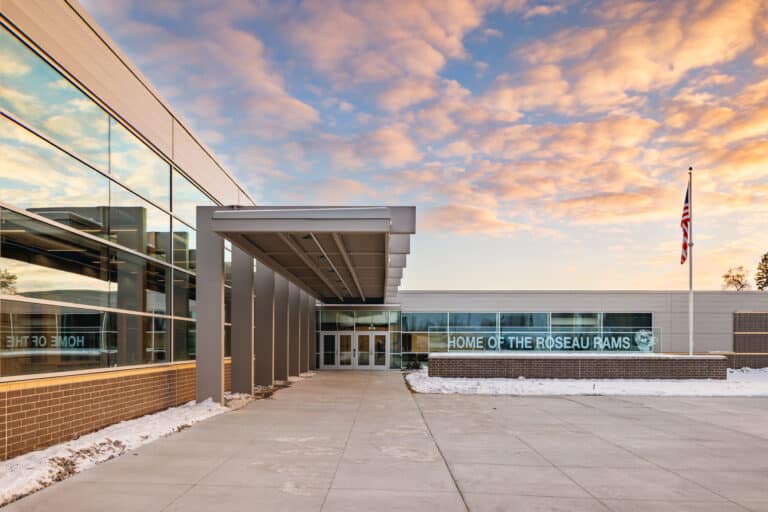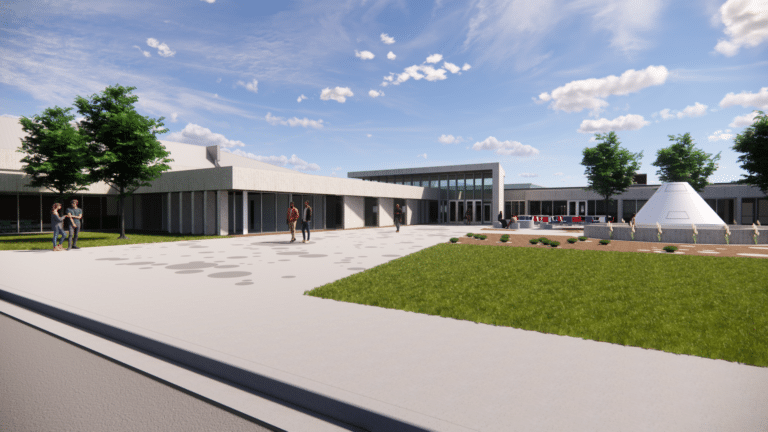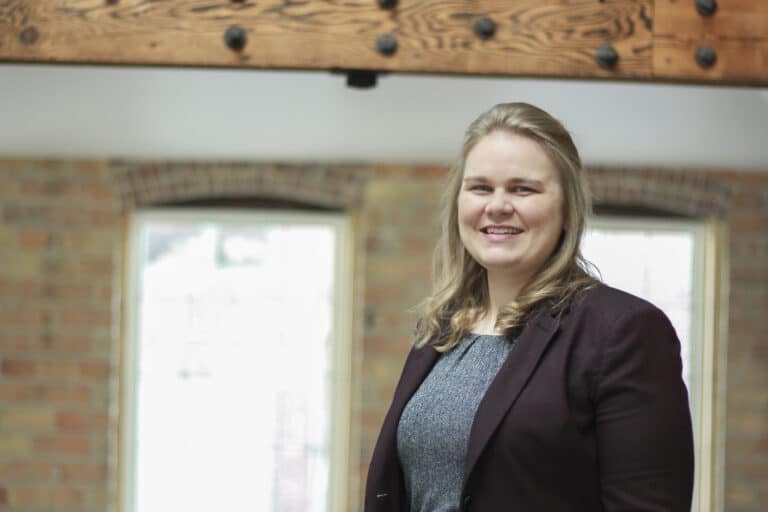Is the average human knowledge really doubling every 13 months? Considering this prediction was made roughly four decades ago, our guess is that it’s now a whole lot faster. While this was first reported in 1981 in author, R. Buckminster Fuller’s book, Critical Path, IBM’s 2013 widely circulated prediction is that our knowledge is on its way to doubling every 12 hours. Thanks to rapid advances in the “Internet of Things,” students are stepping into a world that looks nothing like the one we grew up in. Every generation has overcome new challenges, but today’s students are in the fast lane. New Career Tech Education (CTE) programming helps students keep the pace and chart their course for emerging careers and in-demand workforce needs.
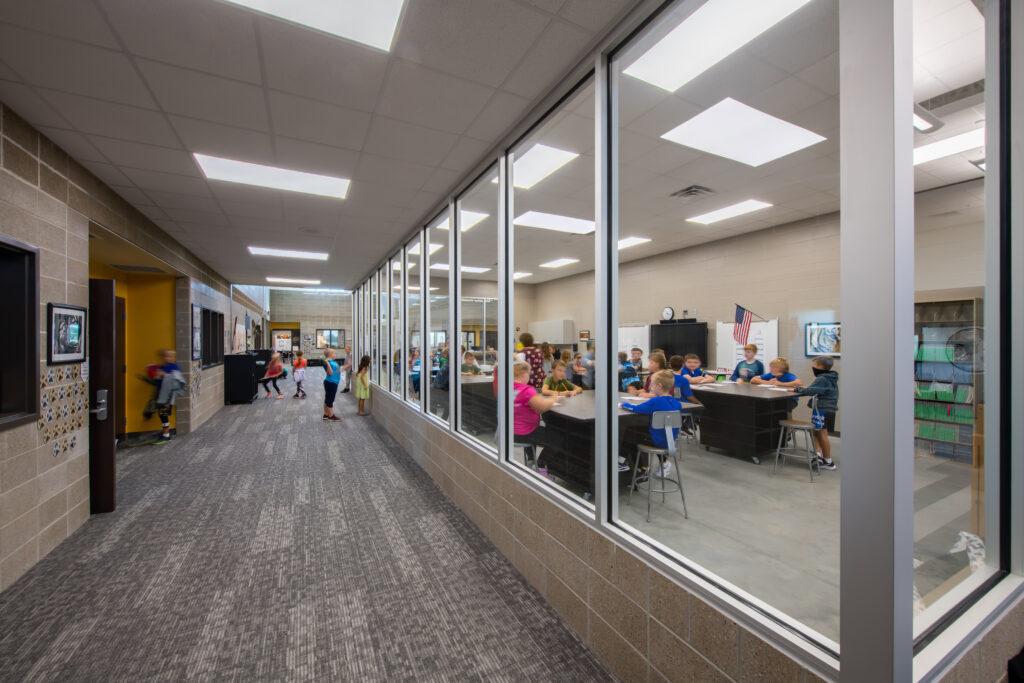 Chad Ziemendorf | The STEM lab is at the heart of the learning environments at Harrisburg Adventure Elementary. The centralized location and glassed walls give every student exposure to STEM principles, sparking their curiosity at a young age.
Chad Ziemendorf | The STEM lab is at the heart of the learning environments at Harrisburg Adventure Elementary. The centralized location and glassed walls give every student exposure to STEM principles, sparking their curiosity at a young age.
Mapping Out the Future of Education
The question on every educator, administrator, parent, and designer’s mind is, “How do we prepare the next generation for this fast-paced world?”
Often the response to this question will reference the 4 Cs: Communication, Collaboration, Creativity, and Critical Thinking. These skills are valuable tools for navigating an ever-evolving world, however, there is a 5th “C” landing high on this list — Curiosity. Kids are naturally curious; a trait learned early in life through our experiences during play. Even if we don’t realize it, immersive and engaging play is a place of constant learning, leading to undiscovered solutions. Curious children tend to be drawn to hands-on tasks and creative problem-solving, without questioning the boundaries.
Today’s students want true-to-life educational experiences that will let them explore a variety of career pathways.
Exploration and creation are our first exposure to CTE and teach students the value of trying, failing, and trying again. When these skills are supported by the right environment, students are given the tools to develop future-ready solutions and chase their curiosity.
At younger ages, this can look like discovery labs, Lego walls, and robotics courses. Curiosity Centers create pathways for young learners towards more advanced trades found in middle school and high school CTE programs. These programs encourage students to chase their curiosity within real-world applications that align with existing opportunities and emerging career pathways in their state, community, and regional industries.
 Micah J. Zimmerman, Amdak Productions | The CTE space at Roseau High School allows for collaboration with the science and math communities, providing a more diverse and richer CTE experience that partners with and dovetails into the career opportunities of local industries.
Micah J. Zimmerman, Amdak Productions | The CTE space at Roseau High School allows for collaboration with the science and math communities, providing a more diverse and richer CTE experience that partners with and dovetails into the career opportunities of local industries.
Reflecting Real Life
Today’s students want true-to-life educational experiences that will let them explore a variety of career pathways. Primarily, students want the work they’re doing in the classroom to be relevant to the work they’ll do post-graduation.
This is where CTE shines. Today, everything is connected. Showing students how the concepts learned in one class relate to another class, as well as its value to careers is life changing. A construction class can explore the application of geometry while a science class makes connections to the agriculture curriculum. If a student dreams of owning their own business, an English essay can demonstrate its value in writing a business plan. Across all classes, application inspires motivation.
Right now, CTE programs are effectively overriding decades of departmental silos, with new connections happening in CNA labs that mimic clinic and hospital settings, business labs that look like Wall Street, and commercial kitchen labs designed collaboratively with your culinary community.
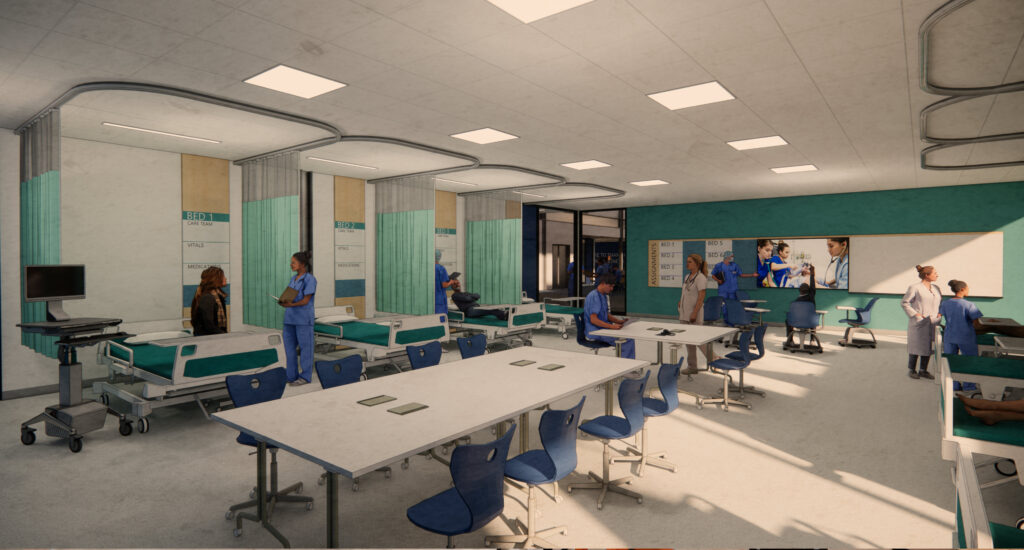 Rendering by by BNDRY | In partnership with local leaders, along with $10 million in matching state funds, the Career Impact Academy supports the vision for a greater Grand Forks Area Career and Technical Center by creating a space for specialized skill development.
Rendering by by BNDRY | In partnership with local leaders, along with $10 million in matching state funds, the Career Impact Academy supports the vision for a greater Grand Forks Area Career and Technical Center by creating a space for specialized skill development.
Community & Industry Partnerships
The renewed interest in Career Tech Education means new connections for local industry and businesses. Career Tech Education invites local businesses into the classroom, giving them space to invest in future leaders. Through partnerships with local districts, businesses can more efficiently communicate in-demand positions, help shape curriculum, and even provide the school with resources to help students succeed. This is a chance to learn the right skills on the right equipment and develop skills that students can take directly from graduation to specialized degrees or immediate career paths in their own backyard.
Many schools are the epicenter of a sustainable workforce and resilient community. Skilled workforce shortages have heightened the need to attract, educate, and train the next generation of electricians, carpenters, machinists, skilled operators, and healthcare professionals — just a few of the high-paying and rewarding careers that students may be overlooking.
Change In Action
The Park Rapids Area School District recognized the impact of CTE on their students’ futures, with most students going into two-year trade programs or directly into the workforce after graduation. This knowledge helped shape their recent building project and their vision for how education would be delivered in the future. District leadership knew that having robust and forward-thinking CTE spaces would be critical to supporting student interests and needs post-graduation.
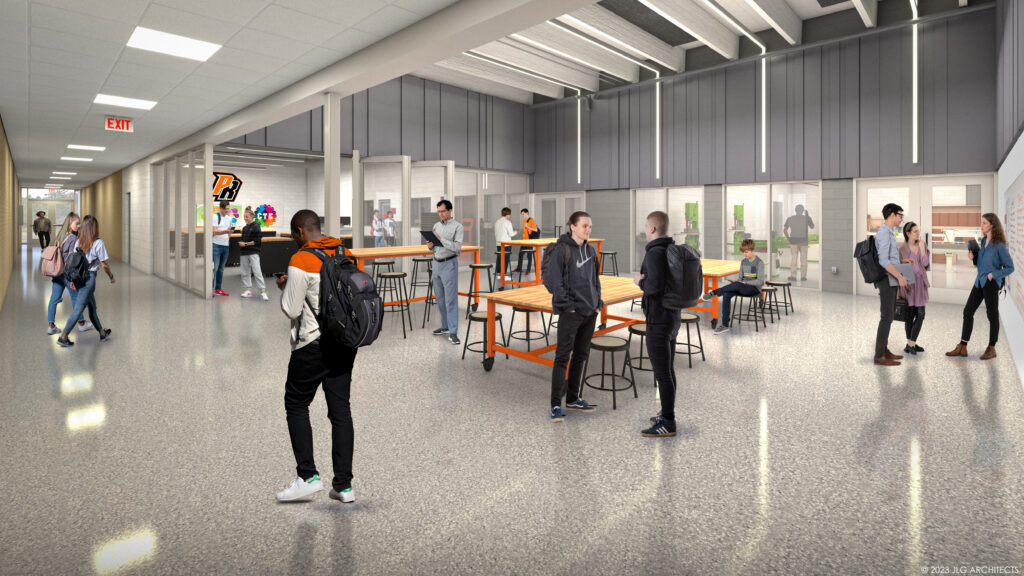 Rendering by JLG Architects | At Park Rapids Area High School CTE opportunities collide in a centralized learning commons, encouraging collaboration between students and programs.
Rendering by JLG Architects | At Park Rapids Area High School CTE opportunities collide in a centralized learning commons, encouraging collaboration between students and programs.
The district challenged the design team to flip the traditional way core and encore classes supported one another — with core classes taking a supporting role. They understood that core classes and elective classes shouldn’t be separated by silos, and that modern education demands collaboration between subjects.
In response, the design team developed a “main street” with encore classes along a spine to create direct visuals into spaces, making them visible to more students. Curious students passing by can now see what’s happening inside the classroom and ask, “How can I do that?”
Today’s CTE students are future industry leaders, future advocates, and future community members who will help communities thrive.
CTE spaces are no longer down the dark hallway at the back of the school, they are centralized and proud, encouraging engagement and celebrating real-life workforce learning driven by community needs. By placing CTE classes that support one another within proximity to each other and closer to traditional core classes, it’s easier for classes to collaborate and build relationships that reflect the post-graduation world. This reimagined space is helping students make the connection between core classes, CTE classes, and post-graduation careers.
Nurturing the Next Generation
Today’s CTE students are future industry leaders, future advocates, and future community members who will help communities thrive. Exposure to new opportunities in CTE gives them the tools to answer the questions like ‘What problem do I want to solve?’, ‘How do I want to solve it?’, ‘How can I use my gifts and talents to do that?’, or ‘What do I need to know to solve that problem?’
These questions are rooted in curiosity and capture the possibilities of a future that CTE is helping shape. The deeper questions build excitement, grow partnerships, and create opportunities that keep schools and communities thriving. Whether graduates choose a direct path to CTE fields or college degrees, they’re headed into the world with valuable experience that will help map out their future, chase their dreams, and ignite curiosity that fosters lifelong learning.
Sources:
Fuller, B. R. (1981). Critical Path. Estate of R. Buckminster Fuller with Kiyoshi Kuromiya
